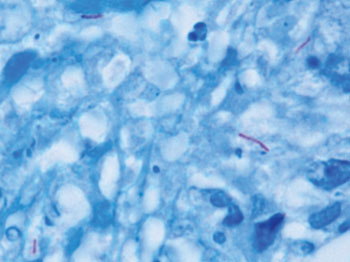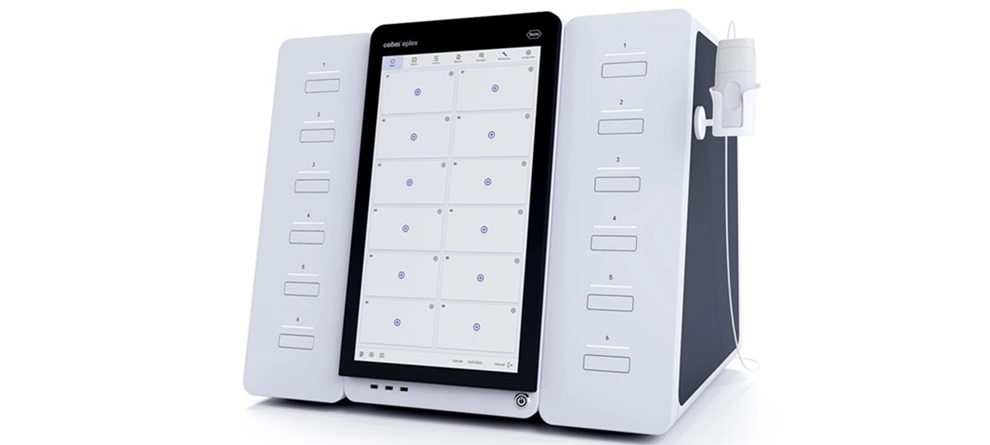Assay Measuring Eight Cytokine Markers Discriminates Active from Latent Form of Tuberculosis
By LabMedica International staff writers
Posted on 19 Jan 2015
A new real-time reverse transcription-PCR (real-time RT-PCR) assay allows diagnosticians to distinguish between active pulmonary tuberculosis (TB) and the latent form of the disease (LTBI), which are disease states that cannot be differentiated by either the tuberculin skin test (TST) or interferon-gamma release assays (IGRAs).Posted on 19 Jan 2015
Investigators at Yonsei University (Republic of Korea) developed a real-time RT-PCR TaqMan assay for targeting levels of eight human targets [IFN-gamma, tumor necrosis factor (TNF)-alpha, IL-2R, IL-4, IL-10, CXCL9, CXCL10, and CXCL11].

Image: Mycobacterium tuberculosis (stained purple) in a tissue specimen (blue) (Photo courtesy of the CDC - US Centers for Disease Control and Prevention).
TaqMan assays are based on probes that consist of a fluorophore covalently attached to the 5'-end of the oligonucleotide probe and a quencher at the 3'-end. The quencher molecule quenches the fluorescence emitted by the fluorophore when excited by the cycler’s light source via FRET (Fluorescence Resonance Energy Transfer). As long as the fluorophore and the quencher are in proximity, quenching inhibits any fluorescence signals. TaqMan probes are designed such that they anneal within a DNA region amplified by a specific set of primers. As the Taq polymerase extends the primer and synthesizes the nascent strand, the 5' to 3' exonuclease activity of the Taq polymerase degrades the probe that has annealed to the template. Degradation of the probe releases the fluorophore from it and breaks the close proximity to the quencher, thus relieving the quenching effect and allowing fluorescence of the fluorophore. Hence, fluorescence detected in the quantitative PCR thermal cycler is directly proportional to the fluorophore released and the amount of DNA template present in the PCR.
Results obtained with the tuberculosis TaqMan assay showed that the sensitivity of TNF-alpha, IL-2R, and CXCL10 in the active pulmonary tuberculosis (PTB) group was 96.43%, 96.43%, and 100%, respectively. The sensitivity of IL-2R and CXCL10 in the latent tuberculosis infection group was 86.36% and 81.82%, respectively. Statistical results showed that TNF-alpha and CXCL9 were the best individual markers for differentiating between the PTB, LTBI, and non-TB groups.
For optimal sensitivity and differentiation of M. tuberculosis infection status, the investigators attempted simultaneous detection of multiple targets. The combination of IFN-gamma, TNF-alpha, and IL-2R, and the combination of TNF-alpha, IL-2R, CXCL9, and CXCL10 showed the best performance for detecting active PTB (both 100% positivity) and LTBI (86.36% and 81.82% positivity, respectively).
"These results imply that a combination of suitable single markers is very useful for the efficient diagnosis and differentiation of Mycobacterium tuberculosis (MTB) infection," said senior author Dr. Hyeyoung Lee, professor of biomedical laboratory science at Yonsei University. "The World Health Organization reports that one-third of the world's population is latently infected with MTB. It has been estimated that in 5% to 10% of LTBI individuals, the infection progresses to an active disease state, and the conversion rate is greater in immunosuppressed individuals such as those with HIV. Therefore, rapid diagnostic tests and effective treatment of LTBI are important to reduce and control the TB burden."
Details of the study were published in the January 2015 issue of the Journal of Molecular Diagnostics.
Related Links:
Yonsei University













